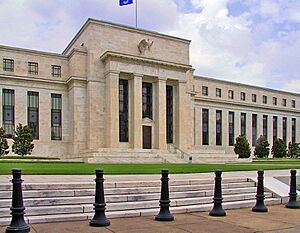Charles August Lindbergh facts for kids
Quick facts for kids
Charles August Lindbergh
|
|
|---|---|
 |
|
| Member of the U.S. House of Representatives from Minnesota's 6th district |
|
| In office March 4, 1907 – March 3, 1917 |
|
| Preceded by | Clarence Buckman |
| Succeeded by | Harold Knutson |
| Personal details | |
| Born |
Carl Månsson
January 20, 1859 Stockholm, United Kingdoms of Sweden and Norway |
| Died | May 24, 1924 (aged 65) Crookston, Minnesota, US |
| Resting place | Lakewood Cemetery, Minneapolis, Minnesota, US |
| Political party | Republican |
| Other political affiliations |
Progressive "Bull Moose" (1912) |
| Spouses |
|
| Children | 4, including Charles |
| Parent | August Lindbergh (father) |
| Alma mater | University of Michigan Law School |
Charles August Lindbergh (born Carl Månsson; January 20, 1859 – May 24, 1924) was an important American politician. He served as a Congressman for Minnesota from 1907 to 1917. He is also well-known as the father of the famous pilot, Charles Lindbergh.
Contents
Early Life and Education
Charles August Lindbergh was born Carl Månsson in Stockholm, Sweden. When he was a baby, his family moved to the United States in 1859. They settled in Melrose, Minnesota.
His father, August Lindbergh, worked as a farmer and a blacksmith. Charles later studied law at the University of Michigan Law School. He graduated in 1883 and became a lawyer that same year.
Charles Lindbergh's Political Career
Lindbergh began his political career as a prosecuting attorney for Morrison County, Minnesota. He held this job from 1891 to 1893.
In 1906, he was elected to the United States House of Representatives. He served as a Republican Congressman for ten years. During this time, he was part of five different Congresses. In 1912, he supported Theodore Roosevelt when Roosevelt ran for president.
Views on War and Banking
When World War I started in Europe in 1914, Lindbergh believed the United States should stay out of the conflict. He was one of only 14 Congressmen who voted against arming American merchant ships in 1917.
Lindbergh was also one of the first politicians to speak out against the Federal Reserve. This is America's central banking system. He believed it gave too much power to a few people. He even wrote a book about his concerns called Banking, Currency, and the Money Trust in 1913.
He also wrote an anti-war book. In 1918, federal agents destroyed the printing plates for his books. This was because his ideas were seen as going against the government during wartime. Lindbergh's strong beliefs against war later influenced his son, Charles.
Running for Governor
In 1918, Lindbergh ran for governor of Minnesota. He was a Republican, but he was supported by a group called the Farmers Nonpartisan League. This group wanted the government to own some farming businesses.
Many people supported his campaign. However, he faced criticism because he was against America joining World War I. He also had ties to the Farmers Nonpartisan League, which some saw as too socialistic. His son, Charles, often drove him to his speeches. Charles remembered the crowds that sometimes threw eggs and rocks at his father. Lindbergh did not win the election in 1918.
He ran for governor again in 1924. This time, he ran as a candidate for the Minnesota Farmer–Labor Party. Sadly, his campaign ended when he passed away. If he had won, he would have been the first Minnesota governor from that party.
Personal Life
In 1887, Charles August Lindbergh married Mary LaFond. They had two daughters, Lillian and Eva. Mary passed away in 1898.
In 1901, Charles married Evangeline Lodge Land. In 1902, they moved to Little Falls, Minnesota. There, Lindbergh started a successful law practice. Charles and Evangeline had one child together, their famous son, Charles Lindbergh, who became a well-known aviator.
Death
Charles August Lindbergh died in 1924 in Crookston, Minnesota. He passed away from brain cancer.
He has a memorial plaque at Lakewood Cemetery in Minneapolis. Following his wishes, his son Charles scattered his ashes near the Sauk River. This was the spot where the first Lindbergh family home once stood.



